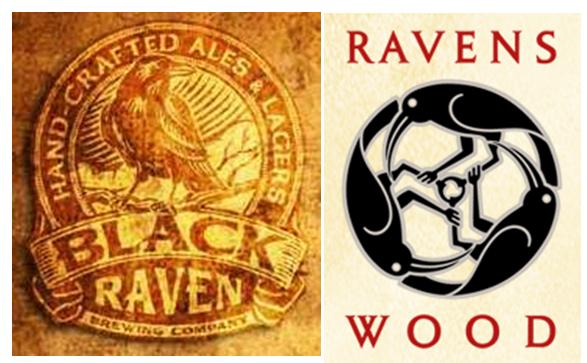Redmond's Black Raven Brewing Company Loses TTAB Fight with Winery
 BeauxKat’s (left) and Franciscan’s raven logos
BeauxKat’s (left) and Franciscan’s raven logos
Redmond, Wash.’s BeauxKat Enterprises, LLC, filed an intent-to-use application to register BLACK RAVEN BREWING COMPANY as a trademark with the Patent and Trademark Office for beer with “brewing” and “company” disclaimed.
Franciscan Vineyards, Inc., opposed on an alleged likelihood of confusion with its prior registrations for RAVENSWOOD, RAVENS WOOD, RAVENS, RAGIN’ RAVEN, and a stylized raven bird design for wine, clothing, and sauces.
On June 21, the Trademark Trial and Appeal Board sustained the opposition.
“We find that the du Pont factors, on balance, weigh in favor of a finding of likelihood of confusion. We conclude that consumers familiar with opposer’s wine sold under the mark RAVENS, would be likely to believe, upon encountering applicant’s mark BLACK RAVEN BREWING COMPANY for beer, that the goods originate from or are associated with or sponsored by the same entity.”
The Seattle-based Brewery Log Blog calls the decision “somewhat of a travesty,” noting the TTAB continues to lump beer and wine together, which could cause problems for both industries.
“This country has a glut of wine and beer producers,” it argues. “Many have extremely similar names (i.e. Stone Cellars v. Stone Brewing; Fat Cat Beer v. Red Cat Wine; Sea Dog, Laughing Dog, Lazy Dog, Spotted Dog and [a] whole mess of other dog breweries and wineries). This could open the floodgates for more challenges in between these two industries.”
Well, I wouldn’t say floodgates, and I question the precedential value of the decision, but TBLB’s point is well taken. And props for watching the TTAB!
The case cite is Franciscan Vineyards, Inc. v. BeauxKat Enterprises, LLC, Opposition No. 91181755 (TTAB June 21, 2010).
Reader Comments (5)
But it might be a well publicized decision for the wine and beer industries. Thus, I wouldn't be surprised to see future similar challenges.
See, e.g., Bell’s Brewery, Inc. v. Bell Hill Vineyards, LLC, Opposition No. 91177980 (T.T.A.B. December 18, 2009) (non-precedential) (“While opposer cites to prior decisions where beer and wine have been found to be related, it is incumbent on opposer to establish this fact based on the evidence presented in its case.”); Parfums de Coeur Ltd. v. Lazarus, 83 U.S.P.Q.2d 1012, 1020 (T.T.A.B. 2007) (rejecting opposer's reliance on a prior Board decision, explaining “[t]here is certainly nothing in the opinion to indicate that if goods were found to be related in one case, they must be considered related in all cases.”).
What is the ruling in regards to the use of the word Raven in a different language? (i.e Cuervo in spanish)
Would there be trademark infringement? Thus allowing Ravenswood to stop trademarking the use of the word Raven in any languages?
Also, the raven as a bird is a general looking animal and there are many variations of said creature. What constitutes a trademark infringement of the pictoral bird? Any artistic representation?
I appreciate your info on this and look forward to your response.